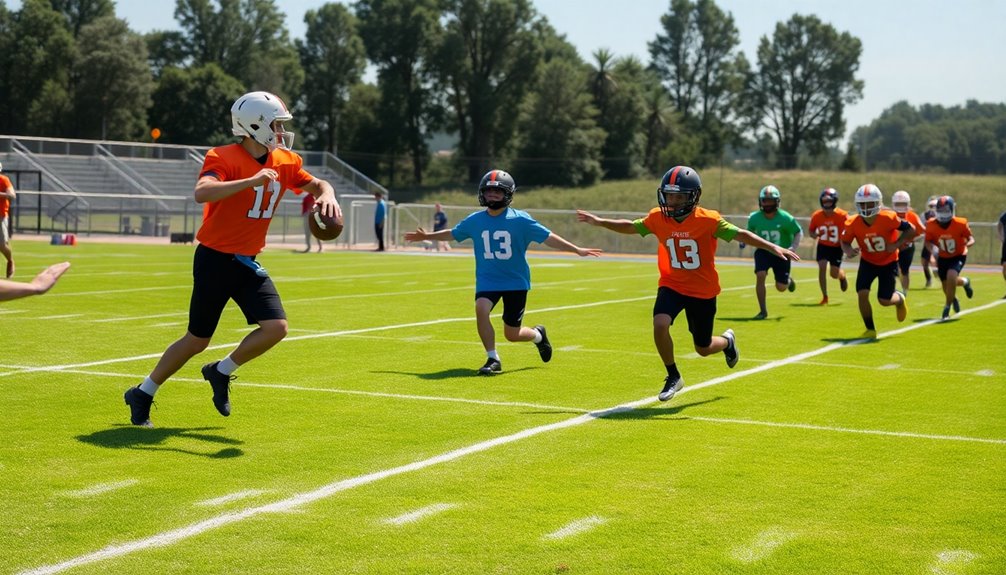
5v5 Flag Football Plays That Work Every Time
January 19, 2025For successful 5v5 flag football plays, focus on quick passes and smart formations. The quick slant route is a game-changer, allowing you to exploit gaps in zone defenses. Use the Bunch Formation for tight spacing and rapid execution. Misdirection plays, like fake handoffs, can confuse defenders, creating open lanes for significant gains. Don't underestimate the power of clear communication on the field—it's essential for executing plays effectively. With practice and adaptability, you'll develop a winning strategy. Keep honing your skills, and you'll find even more ways to outsmart your opponents on the field.
Overview of Effective Plays
When it comes to effective plays in 5v5 flag football, understanding the dynamics of quick passes and strategic formations is essential. Utilizing formations like the Spread Formation creates maximum spacing, making it harder for defenders to cover all options. This setup opens up opportunities for quick passes, particularly the Quick Slant Route. This route is a game-changer, allowing receivers to exploit soft spots in zone coverage and gain valuable yardage. To enhance passing efficiency, it is also crucial to prioritize passing accuracy. Effective communication is also vital for ensuring all players are on the same page regarding their roles and responsibilities.
Incorporating trick plays into your strategy can also catch defenses off guard. For example, an option pass can turn an ordinary play into a surprising offensive advantage. Additionally, employing combination routes where two receivers run coordinated patterns can confuse defenders, greatly increasing your chances of success on critical downs.
Consistent practice is key. The more you rehearse these effective plays, including variations like the Bunch Formation, the better you'll understand your roles and improve overall team execution. Furthermore, successful plays in any team sport rely on collaboration among players, which enhances performance and leads to a higher chance of scoring. In soccer, the role of midfielders is particularly important, as they link defense and attack, similar to how players must connect on the field in flag football.
Key Formations for Success
Mastering effective plays requires a solid understanding of key formations that can elevate your team's performance on the field. The Deuce Formation is foundational, providing a balanced setup with one back, which supports versatile play calling for both run and pass options. This formation is essential for teaching various plays effectively.
Moving to the Twins Formation, you can leverage two receivers to facilitate combination and crossing routes. This setup enhances offensive effectiveness while still allowing for run plays like jet sweeps and reverses.
The Trips Formation aligns multiple players on one side, enabling complex route combinations and sprint-out passing. This helps your quarterback execute a three-level passing game seamlessly.
When facing man coverage, the Bunch Formation shines. Its tight spacing allows for quick route execution and rapid quarterback releases, boosting your chances of successful plays.
Lastly, the Bunch Stack Formation uses three closely aligned receivers to confuse defenses. This creates mismatches and opens up dynamic offensive plays, including jet sweeps. Additionally, understanding tactical considerations in formation selection can help refine your game strategy and enhance overall team effectiveness.
Quick Passing Techniques
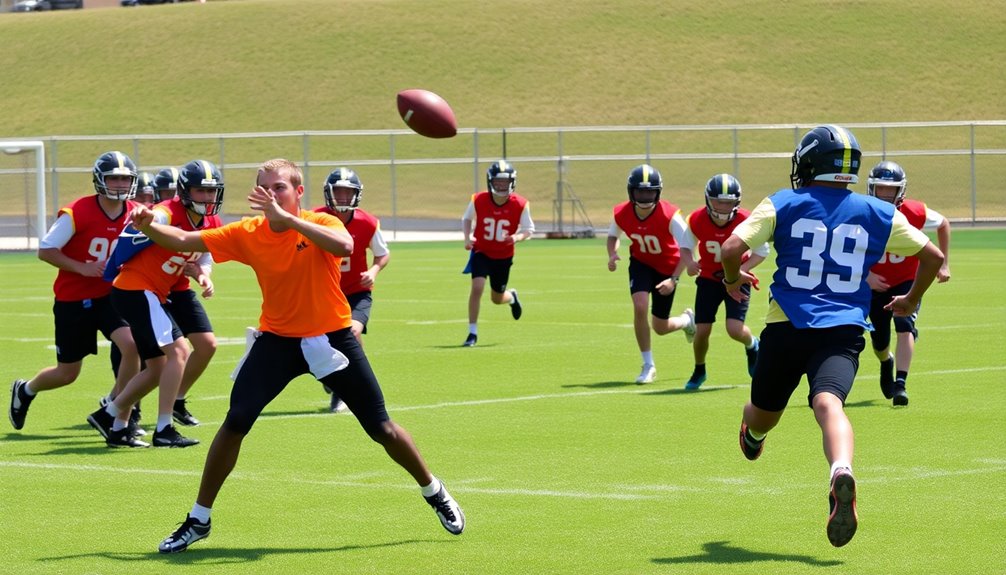
Quick passing techniques are essential for gaining immediate yardage and keeping the defense off balance in 5-on-5 flag football. One effective method is utilizing slant routes, which allow receivers to exploit gaps in defensive coverage quickly. By incorporating motion before the snap, you can create mismatches that give your receivers a step on their defenders, setting up for a quicker pass. Additionally, practicing endurance training methods can enhance a player's ability to maintain speed and agility throughout the game.
The quarterback's quick release is imperative; it minimizes the time defenders have to react, increasing your chances of successful completions. Additionally, using combination routes—where two receivers run intersecting patterns—can confuse defenders, opening quick passing lanes for the quarterback. Understanding defensive responsibilities is crucial for identifying the best moments to execute these quick passes effectively. Consistent practice of these techniques reinforces muscle memory, allowing players to react instinctively during games.
Practicing these quick passing techniques consistently not only sharpens your execution but also enhances team chemistry, which is essential for maximizing offensive efficiency. When everyone knows their role and timing, your team can capitalize on defensive lapses, turning short passes into significant gains.
Misdirection Plays Explained
Utilizing quick passing techniques sets the stage for incorporating misdirection plays, which can greatly enhance your offensive strategy.
Misdirection plays rely on deceptive movements that confuse defenders, drawing their attention away from the actual ball carrier. By executing fake handoffs or motions, you can lead defenders to commit to the wrong player, creating open lanes for successful plays. This concept of pressure and cover is vital in ensuring that your fake movements are effective against the defense.
Imagine a running back faking a run one way while the quarterback or another back takes the ball in the opposite direction. This kind of play not only keeps defenders guessing but also opens up opportunities for significant yardage gains.
However, timing and execution are critical. It's vital that your team practices these movements to guarantee that fakes and misdirections are convincing and well-coordinated.
Incorporating misdirection into your playbook adds an element of surprise, making it harder for defenses to predict your next move. To achieve this, developing technical skills through consistent practice can significantly improve your team's overall effectiveness.
The more unpredictable you are, the better your chances of executing successful plays. So, focus on mastering these techniques, and watch your offense become a formidable force on the field.
Importance of Team Communication
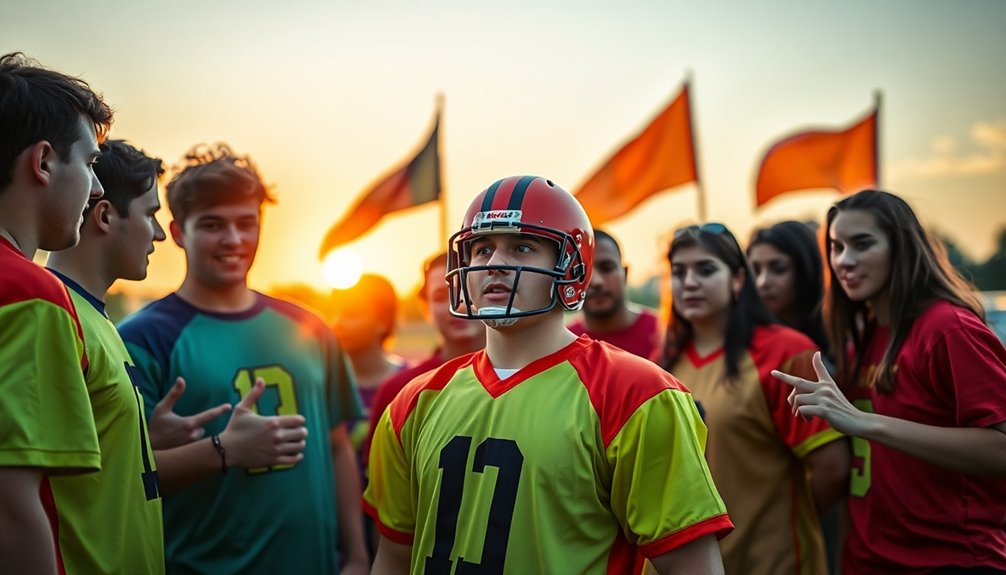
In flag football, clear play signals are essential for keeping everyone on the same page. You need to maintain constant verbal communication to coordinate movements and strategies effectively. When players interact openly, it reduces confusion and enhances overall team performance. Moreover, fostering strong team dynamics can lead to improved team communication and better execution of plays on the field. This unity and collaboration is crucial, as teamwork and unity play a significant role in achieving success. Additionally, establishing a consistent routine for practice can enhance mental strength, which is vital for executing plays under pressure.
Clear Play Signals
Effective communication on the field can really make or break a game, and clear play signals are essential for guaranteeing every player is on the same page.
When you establish these signals, it enhances team communication, minimizes confusion, and maximizes execution efficiency in fast-paced situations.
Here are some key benefits of implementing clear play signals:
- Quick reference: Using wristbands for play calls reduces the need for lengthy verbal communication.
- Pre-defined hand signals: Create a shared vocabulary that helps with coordination and teamwork.
- Simplicity: Guarantee signals are straightforward and easy to remember for quick processing under pressure.
- Regular practice: Reinforce play signals during training sessions to improve communication skills and understanding of roles.
- Improved performance: Consistent use of signals leads to better execution in games.
Constant Verbal Communication
To keep your team in sync during a game, constant verbal communication is key. This enhances on-field coordination, allowing players to make quicker adjustments to defensive shifts during plays. When you prioritize communication, you can see a 20-30% improvement in play execution; this happens because players anticipate each other's movements and intentions better.
Regularly practicing vocal cues during drills fosters a culture of communication, which builds confidence and trust among teammates. When everyone knows their roles and responsibilities, you'll reduce the likelihood of penalties and mistakes.
Implementing a standardized set of verbal signals is essential for seamless shifts between plays. This helps your team maintain tempo and momentum throughout the game.
Encourage all players to shout out cues, call for the ball, or alert teammates about defensive movements.
Single Back Formation Strategy
How can the Single Back Formation elevate your flag football game? This formation positions one back behind the quarterback, offering a balanced attack that effectively utilizes both passing plays and running options. The importance of player conduct in maintaining a competitive spirit can also be reflected in this formation, as it encourages teamwork and strategy. Unity on the soccer field is essential for success, and this formation fosters a similar spirit in flag football.
Its versatility keeps defenses guessing and creates mismatches, making it a smart choice for any team.
Here are some key strategies to maximize the Single Back Formation:
- Utilize Quick Passes: The quarterback can quickly release the ball, targeting open receivers and exploiting defensive gaps.
- Incorporate Receiver Routes: Use a mix of routes like post, corner, fly, and slant to keep defenders on their toes.
- Implement Motion: Moving players before the snap can confuse the defense and create space for your receivers.
- Balance Your Attack: Combine running plays with passing plays to maintain a dynamic offense and prevent predictability.
- Adapt for All Skill Levels: This formation simplifies route concepts, making it accessible for both experienced teams and newcomers.
Additionally, the Single Back Formation allows teams to execute popular moves effectively, which can be crucial for gaining an edge in competitive games.
Spread Formation Advantages
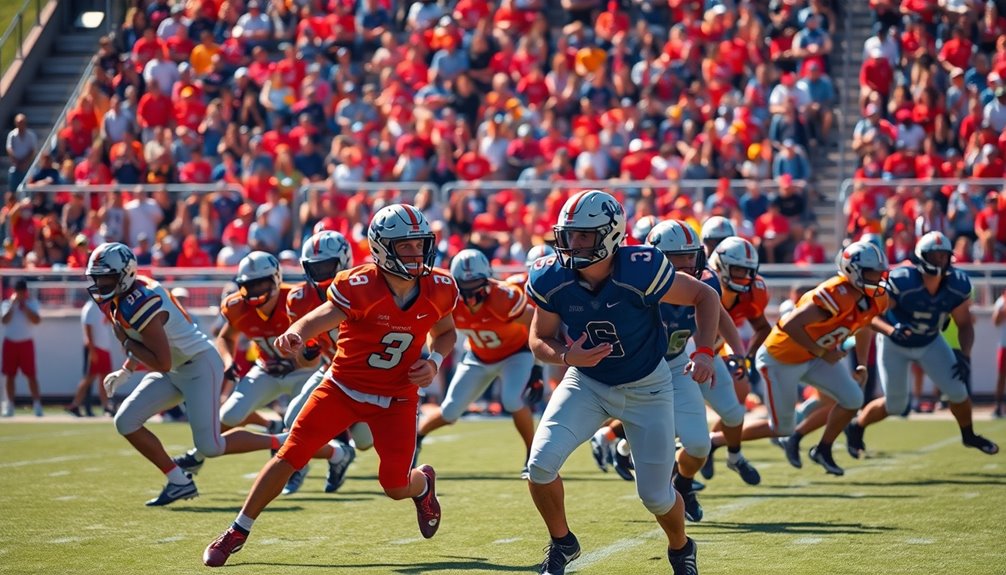
When you use the Spread Formation, you're able to exploit defensive gaps like never before.
By positioning your receivers wide, you can confuse opponent coverage and create mismatches that lead to successful plays.
This strategy not only opens up the field for quick passes but also sets the stage for effective running plays.
Exploiting Defensive Gaps
In the Spread Formation, teams can effectively exploit defensive gaps by spreading the field and forcing defenders to cover more ground. This layout creates space, allowing your receivers to maneuver freely.
As you utilize motion before the snap, you can shift defensive focus and open up even more opportunities, making it easier to target those gaps.
Here are some strategies to enhance your effectiveness in exploiting defensive gaps:
- Juke and Option Routes: Use these to create separation and take advantage of mismatches based on speed.
- Quick Passes: Deliver fast throws to your receivers, capitalizing on the moment when defenders are out of position.
- Multiple Passing Lanes: The formation opens various options, keeping defenders guessing and misaligned.
- Spacing: With three receivers on the line, your team can stretch the defense, making it harder for defenders to cover effectively.
- Defensive Misalignment: Create confusion among defenders, increasing the likelihood of successful plays by forcing them to react quickly.
Confusing Opponent Coverage
One effective way to confuse opponent coverage is by leveraging the unique advantages of the Spread Formation. By aligning all three receivers on the line, you maximize field spacing and create opportunities for quick, short passes that exploit defensive gaps. This strategy forces defenders to make snap decisions, which can lead to missed assignments and open routes.
Incorporating juke, fly, and option routes within the Spread Formation adds another layer of confusion for defenders. As you utilize motion before the snap, you can manipulate defensive alignments and reveal their coverage schemes. This insight enhances your quarterback's decision-making, allowing for strategic plays that can catch the defense off guard.
The horizontal stretch created by the Spread Formation not only opens up space for receivers but also gives running backs more room to maneuver, increasing the potential for big plays.
Its versatility allows for quick adjustments against different defensive strategies, making it effective against both man-to-man and zone coverage. By consistently using the Spread Formation, you can keep opponents guessing and create mismatches that work in your favor.
Utilizing Bunch Formation
The Bunch Formation can be a game-changer for your offense, positioning three receivers tightly together to create confusion among defenders. This close alignment not only enhances teamwork but also opens up opportunities for effective crossing routes that can exploit mismatches, particularly against slower defenders.
Here's how to make the most of the Bunch Formation:
- Crossing Routes: Utilize these to create separation and confusion, making it harder for defenders to switch assignments.
- Quick Route Execution: With the receivers close, the quarterback can release the ball quickly, maximizing yardage after the catch.
- Jet Sweeps: This formation is perfect for incorporating jet sweeps, keeping defenses on their toes.
- Mismatches: Adjust the splits of your receivers based on their skill sets to target specific defenders effectively.
- Teamwork: Encourage communication within the group to execute complex plays smoothly.
Effective Trips Formation Plays
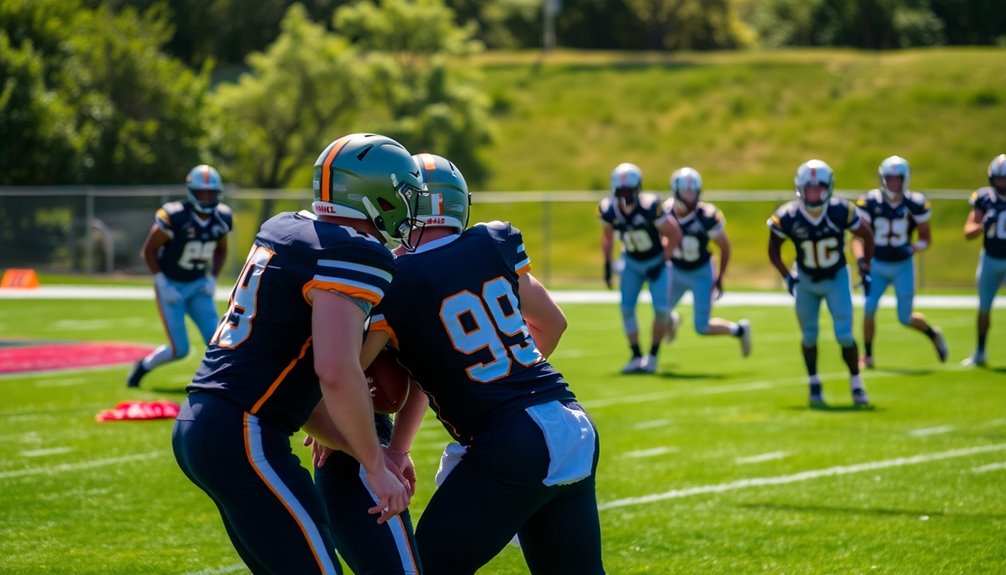
When you set up in the Trips Formation, you open the door to key routes that can exploit mismatches and confuse the defense.
By implementing effective defensive misdirection techniques, you can create opportunities for your receivers to break free and make big plays.
Let's take a closer look at how to maximize this formation for your team's success.
Key Routes Explained
How can you effectively utilize the Trips Formation in flag football? This formation is a powerful tool that allows you to confuse defenders and create mismatches. By aligning three receivers on one side, you can exploit defensive gaps with a variety of key routes.
Here are some essential routes to include:
- Option Routes: Give your receivers the freedom to adjust based on the defense's coverage.
- Quick Slants: These routes provide quick-release options for the quarterback while maximizing field spacing.
- Corner Routes: Effective against man coverage, corner routes can create separation and extend plays.
- Staggered Alignment: Helps create natural picks and rubs, allowing receivers to gain the necessary separation.
- Communication: Critical for timing and coordination among receivers, ensuring everyone is on the same page.
Defensive Misdirection Techniques
Utilizing defensive misdirection techniques is essential for maximizing the effectiveness of the Trips Formation in flag football. By aligning three receivers on one side, you create mismatches that allow for dynamic route combinations. This setup can create defensive confusion, making it tough for defenders to communicate and cover their assignments effectively.
Incorporating motion within the Trips Formation enhances misdirection, keeping the defense guessing about which receiver will be the primary target. You can also utilize option routes, giving receivers the flexibility to adjust based on the defense's alignment. This adaptability increases your chances of finding open lanes for successful completions.
The close alignment of receivers facilitates quick crossing routes that disrupt man-to-man coverage, allowing your quarterback to exploit openings. When executed correctly, these techniques lead to breakdowns in defensive communication, enabling you to capitalize on mismatches.
Incorporate these defensive misdirection techniques into your game plan, and you'll see significant improvement in your offensive efficiency. The key is to keep your opponents on their toes, ensuring they can never predict your next move, ultimately leading to more scoring opportunities.
Defensive Strategies to Counter
Effective defensive strategies are vital for countering the diverse offensive plays in 5v5 flag football. By implementing a combination of techniques, you can greatly increase your chances of success on the field.
Here are some key strategies to keep in mind:
- Zone coverage: This limits passing options, forcing quarterbacks into tightly guarded areas, thereby increasing turnovers or incompletions.
- Blitzing strategy: Apply pressure on the quarterback to disrupt their rhythm, leading to hurried throws and potential mistakes.
- Shadow key offensive players: Assign a free man to neutralize the impact of the most dangerous offensive players, maintaining control of the game.
- Maintain gap integrity: This is critical when defending against running plays, preventing offensive players from exploiting openings for considerable yardage.
- Adjust defensive formations: Tailor your formations based on the offensive team's tendencies to better anticipate their plays and enhance your overall defensive effectiveness.
Trick Plays for Surprise
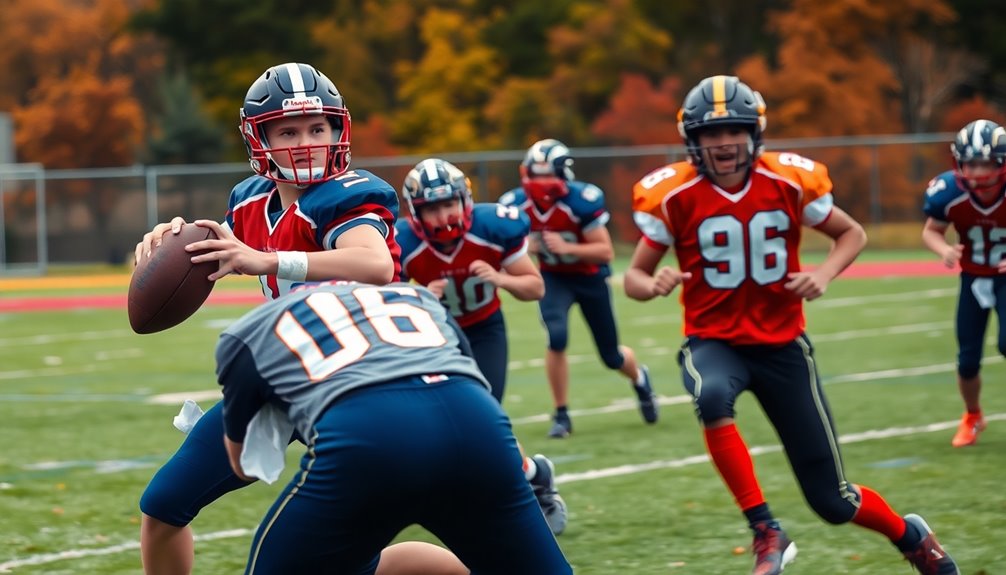
After implementing solid defensive strategies, surprising your opponents with trick plays can shift the momentum in your favor. Trick plays like the "reverse" or "double pass" can effectively confuse defenders when executed with precise timing and practiced coordination among players.
Utilizing misdirection is key; for instance, a running back can fake a handoff while another player receives the ball, creating opportunities for unexpected offensive advances that exploit defensive gaps.
The "flea flicker" is a classic play where the quarterback hands off the ball to a running back, who then tosses it back to the quarterback for a deep pass. This play can easily catch defenses off guard.
Additionally, incorporating a "fake punt" or "fake field goal" strategy during critical moments can lead to surprising yardage gains when the defense isn't expecting a pass or run.
Success with these trick plays hinges on clear communication and deception. It's essential for players to sell the fake effectively, maximizing the surprise element against the opposing team.
When executed correctly, these tactics can leave your opponents scrambling and create scoring opportunities that change the game's outcome.
Adapting to Game Situations
In 5v5 flag football, adjusting your offensive strategies based on the defense is essential for success.
Recognizing their formations and being flexible with player positions can open up opportunities that catch them off-guard.
Adjusting Offensive Strategies
When it comes to adjusting offensive strategies, understanding your opponent's defensive formations is essential. By analyzing their setup, you can identify weaknesses to exploit with targeted route combinations and play selections.
Here are some key tactics to enhance your offensive game:
- Utilize motion: Move players before the snap to create mismatches and confuse defenders.
- Adjust formations: Change receiver spacing based on yardage needed for first downs or touchdowns.
- Incorporate trick plays: Use these sparingly but effectively to catch the defense off-guard, guaranteeing players know their roles well.
- Assess previous plays: Evaluate the success of earlier attempts and tweak routes accordingly to maintain offensive momentum.
- Maximize spacing: Ensure receivers are positioned to create multiple options, whether for short gains or deep threats.
Defensive Formation Responses
Effective defensive formation responses are essential for adapting to various game situations. You'll want to start with man-to-man coverage to match your defenders against specific offensive players, limiting their options while enhancing accountability.
When the offense shifts strategies, make zone coverage adjustments; formations like Cover 2 and Cover 3 are effective at guarding against quick passes while maintaining depth against longer threats.
Consider employing blitzing strategies to apply pressure on the quarterback. Positioning your rusher seven yards back creates strategic depth, allowing for opportunities to pull flags before the ball is released.
Customizing defensive formations based on the offensive tendencies you observe during the game is vital. Utilizing formations like Cover 4 or Cover 1 can help counter specific threats effectively.
Player Position Flexibility
Adapting to game situations often hinges on player position flexibility, allowing teams to exploit mismatches and optimize performance.
By encouraging players to develop multiple skill sets, you can create a dynamic offense that keeps defenders guessing. Utilizing formations effectively enhances this adaptability, enabling seamless shifts throughout the game.
Consider these strategies to enhance player position flexibility:
- Dynamic Roles: Use formations like Twins or Bunch to let receivers switch between running routes and blocking as needed.
- Confusion for Defenses: Implement the Empty Crunch formation, fostering an environment where players can adapt on the fly.
- Run-Pass Options (RPOs): Incorporate RPOs in formations like the I Bone to maximize your offensive potential, allowing smooth shifts between running and passing.
- Player Development: Encourage players to master various skill sets so they can fill multiple positions, maintaining performance regardless of the situation.
- In-game Adjustments: Teach players to read defenses and adjust their roles accordingly, ensuring your team remains unpredictable.
With these strategies, you'll enhance your team's adaptability and offensive effectiveness while keeping the competition on their toes.
Youth Engagement in Flag Football
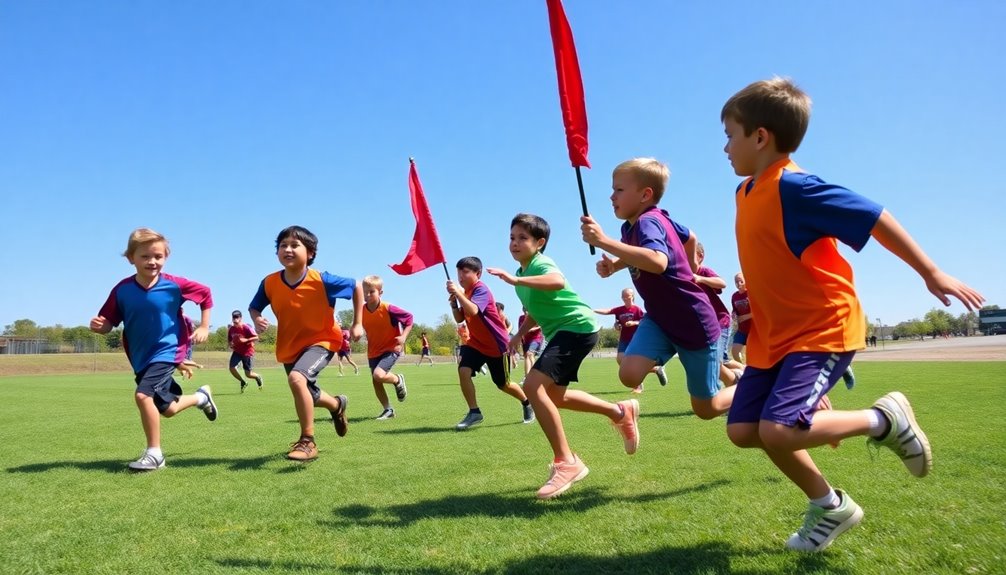
Getting kids involved in flag football is a fantastic way to boost their physical fitness while teaching them essential teamwork and social skills. When you engage youth in this sport, you're not just promoting fitness; you're laying the groundwork for personal development and community involvement.
Flag football allows young players to develop fundamental skills like passing, catching, and understanding game strategies, preparing them for future organized football programs.
Creating an inclusive environment where every child feels welcome is key to youth engagement. Programs that focus on fun and inclusivity lead to higher retention rates and increased participation in future seasons.
By emphasizing teamwork, you help kids learn to collaborate and communicate effectively, building lasting friendships along the way.
Plus, flag football provides a safe introduction to the sport, reducing the risk of injury while still delivering the excitement of competition. Access to training materials and drills enhances skill development, fostering a positive learning atmosphere.
Resources for Coaches and Players
For coaches and players looking to enhance their flag football experience, a wealth of resources is available to support skill development and strategic understanding.
These tools can streamline your training sessions and improve overall performance on the field.
Here are some valuable resources to take into account:
- Comprehensive Playbook: Access a playbook featuring at least 80 plays tailored for various age groups and skill levels.
- Training Materials: Utilize video tutorials and instructional content to grasp essential skills and game fundamentals.
- Practice Schedules: Implement structured practice schedules that keep sessions engaging and focused on skill development.
- Coaching Clinics: Attend coaching clinics and workshops for networking opportunities and to share insights with fellow coaches.
- Player Safety Equipment: Get recommendations on equipment that guarantees players are properly outfitted, enhancing safety and performance during games.
Conclusion
In flag football, finesse fuels fun and fosters teamwork. By mastering these memorable plays and formations, you can elevate your game and engage your teammates. Remember, communication and creativity can convert challenges into chances for victory. So, stay sharp, strategize smartly, and surprise your opponents with clever tactics. With practice and passion, you'll transform into a formidable force on the field, turning every play into a potential point. Embrace the excitement and enjoy the game!


